To America・Origami Greeting ・From the heart
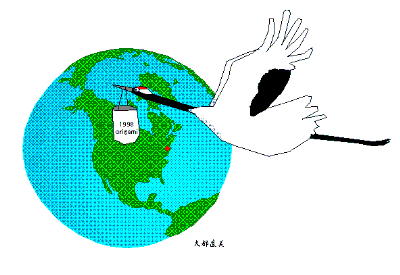 |
| NAOMI OTSU 5th Grade Class |
学年委員長 大都シャーロット Charlotte Otsu
○この報告は平成10年度に5年生のPTA学年委員が企画し、学校側と協力して行った活動記録です。アメリカで美術と言語学を学び、オレゴン大学でAmerican English Instituteの教師をしていた大都さんをはじめ、国際理解学習を主体的に推進した、学年PTAの皆様に深く感謝いたします。-子どもたちに素晴らしい体験と思い出を与えてくれました。平成11年度の3月まで交流が続きました。
[クロスカルチャー美術の教育的な価値]
日本の子供達に * 自分の手で、創造的に作り出す作品を通じて、線、形、色などの造形的美しさを表現し、その作品によって、日本文化、個人の興味と好みなどを外国の子供達に伝えることができる。
* 制作する喜び、完成する喜び、お互いに教え合う喜びの体験ができる。 * 完成作品を活用する喜び、共同制作の喜びの体験を味わうことができる。アメリカの子供達に
* 多くの子供達にとって、初めての美術的日本文化の出合いになる。 * 美的情操と造形感覚を向上させる。
* 想像力や形体認識力を育成する。 大都シャーロット
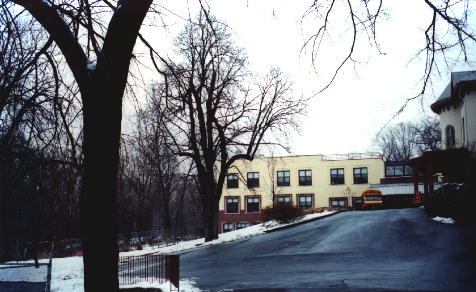 |
 |
| 5250 Fieldston Road | Bronx,NY USA 10471-2999 |
| <学年だより> 平成10年10月9日 中青戸小学校61人の5年生は、New Yorkリバデール小学校61人の6年生と文化の交流をすることになりました。 国際的な交流をするなら、どのような挨拶が良いでしょうか。お互いに言葉と習慣が違いますけども…。大丈夫です。一つのコツがあります。心を開いて、自分の文化を紹介することです。新しい経験ですが、親子と先生方のご協力で、日本の伝統的な手芸である折紙をNew Yorkに贈ります。アメリカでは 折り紙というのはあまり見たことはなく、作ったことのない魅力がある宝物のようです。その折り紙は言葉と同じように素晴らしい国際的なグリーティングになります。 ◇日時:10月22日(木)2:30~3:30 ◇場所:図書室 |
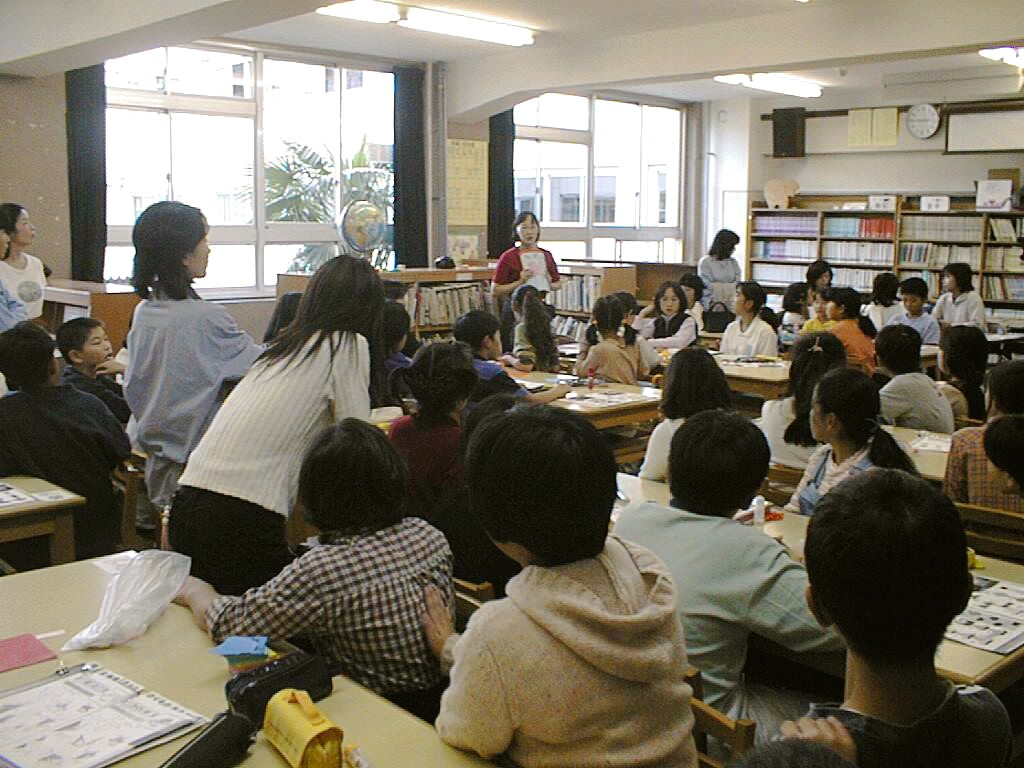 |
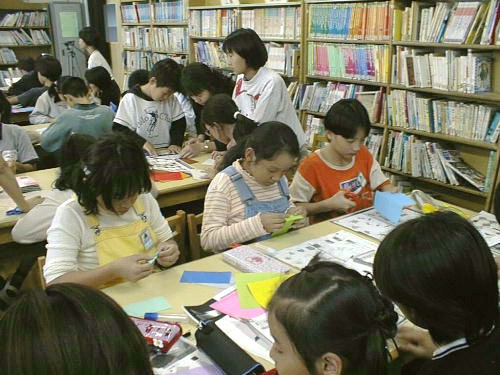 |
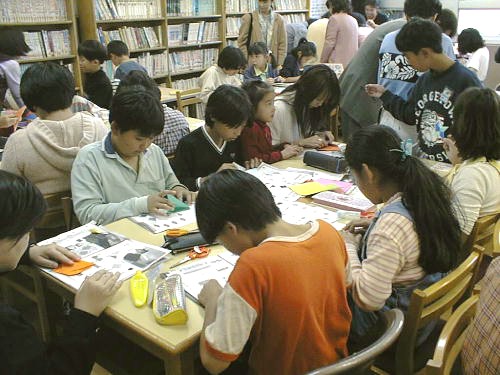 | ||
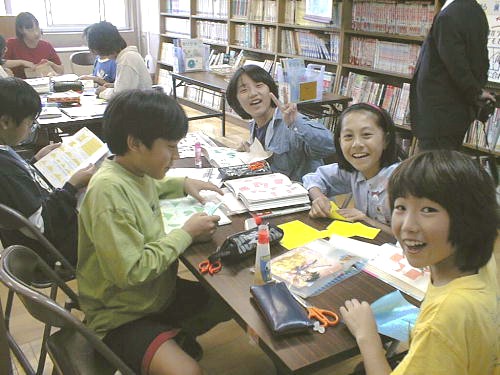 |
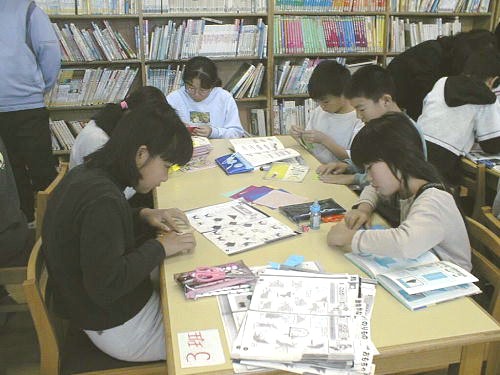 |
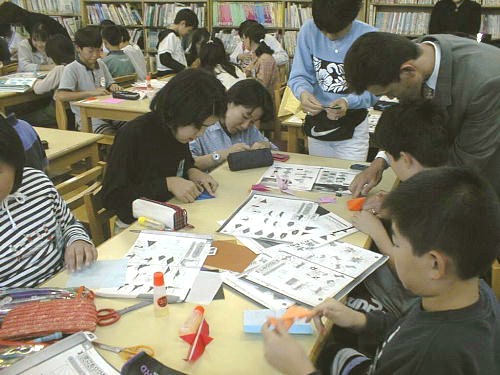 |
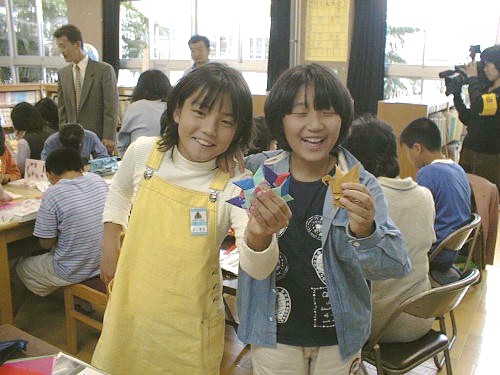 |
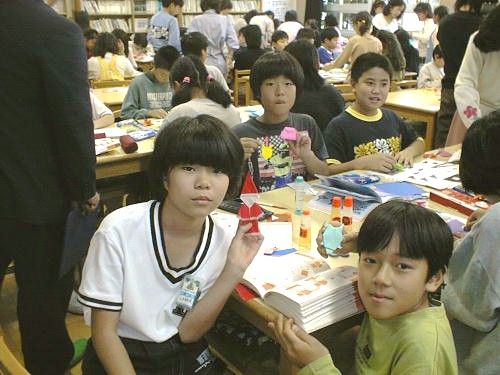 |
●折紙の制作にあたっては、日本折紙協会の大橋皓也先生(上越教育大学名誉教授)、田中陽子先生(山梨県女子短期大学教授)から、たくさんの資料や本をに送っていただきました。ありがとうございました。この折り紙の資料を中青戸小の子ども達が使い、又その資料をリバデール小の子ども達に送りました。お二人の先生方の感想ですが、「日米の子ども達の心の交流に少しでも役立つことが出来たとすれば、こんな喜びはありません」とは大橋先生のお言葉です。「日本とアメリカの子ども達のお互いに印象に残る活動であったことを嬉しく存じます」とは田中先生のお言葉です。
○中青戸小学校とリバデール小学校は飛行機で、何時間もかかる距離で遠く離れています。しかし、先生方と子どもたちの親はお互いに同じ心と夢を持っています。PTA学年活動を企画しながら、その共通点を発見しました。皆さんの夢は他の国の文化を学ぶことと国際的な交流の素晴らしさを子どもたちに伝えたいことでした。ですから、この折り紙での挨拶のことに理解と関心を持ち、色々なアイデアと自分の力と夢を合わせ、協力して下さいました。中青戸小学校とリバデール小学校ではこのような国際的な交流の前例がなかったのですが、皆さんと心を合わせる機会ができて、良かったです。Thanks
to: 中青戸小学校:山口校長先生、菅沢教頭先生、5年1組の中沢先生、5年2組の栄先生、図工とコンピュータの川島先生、荻野先生、大喜先生、と吉井先生
中青戸小学校の5学年のPTA MEMBERS
Riverdale Country School: Lower School Headmaster, Mr. Sandy Shaller,
Assistant Head, Ms. Teri Hassid, Grade 6 Teacher, Ms. Antoinette Quarshie
Grade 6 Parent, Ms. Yuko Niizuma
この活動を企画するとき、両方の国の先生方と親の意見を聞かせていただきました。
○自分の国の文化の親しいものによっての表現なら、きっと中青戸小の5年生達は心の気持ちを遠慮なく、他の国の子供たちに伝えられると思っていました。その文化的な交換と交流の機会を与えられたら、子供たちが立派な心のメッセージを送り、その上に喜んでくれると信じていました。
"Give the children a chance,
give them a dream to hold onto,
and see what they can do."
子供たちにチャンスを与え、
彼らがずっと持てる夢を与え、
そして、彼らが何ができるか見守ってみよう。
○中青戸小学校の5年生達は折り紙の作品と自分の名前のしおりを作りました。全員が漢字とローマ字で名前を書きました。アメリカの子供達と同じ言葉ができなくても、自分の思うことを伝えてみたい子供たちの数人がいました。どのようにそれを表現すればいいでしょうか。子供たちの工夫した解決は日本語と英語をあわせた心のコミュニケーションでした。そして、一番人気のある言葉はやはりHELLOでした。
○子供たちの数人が名前のしおりにマンガと、人気のあるキャラクター(CHARACTER)と、好みの絵を(スポーツと動物など)描きました。そのパーソナル・メッセージの考えは自分の興味があるものを向こうの子供たちに紹介したいという気持からでしょうか。他の例は日本のイメージとシンボルもありました。日本の地図と旗などです。みなさん、素晴らしいメッセージでした。そして、当日、中青戸小5年生全員の笑顔はもう一つの素晴らしい作品と暖かいメッセージだったのでは…。楽しかった。
Thanks to: 中青戸小5年1組 と5年 2組
Written by PTA 5学年委員長 大都 シャーロット ・Mrs. Charlotte Otsu
January 29, 1999
October 1998
This year a new theme has been created for the 5th grade PTA activities. The theme "International Cultural Exchange" will be the main focus of our 2nd term parent/child/teacher PTA activity. This activity will promote cultural exchange between one Japanese elementary school and one American elementary school. The cultural exchange will take the form of 61 Japanese 5th grade students making origami to send to 61 American 6th grade students. The goal of the activity is to open a door of communication between two countries on the level of the elementary school age. The medium of communication will be the art of paper folding called origami. Our hope is that although a language barrier exists, through the opportunity of sharing a Japanese art/craft, children from both countries will have an opportunity to learn about each other and share a new educational experience which will enhance their international understanding.
Goal of the cultural origami sharing. 1. Create a wide variety of different shapes and designs of origami. (animal, fish, people, etc...) 2. Fold traditional as well as newly created origami designs. 3. Allow each individual child to freely choose his or her own origami subject matter to send to America. 4. Recognize the individual origami ability levels of each child. Prepare various levels of origami instructions ranging from easy to difficult. 5. Provide the children with an interesting variety of origami paper to fold. (Japanese washi, chiyogami, traditional Japanese printed paper, irogami, colored origami paper, and modern print origami paper. 6. Have parents and teachers join in making origami with the children.
Time: October, 22, l998 2:30-3:30 Location: Nakaaoto Elementary School Library Activity Theme: To America : an Origami Greeting from the heart. Use of PTA Funds: Postage costs will be covered by 5th grade PTA budget Required Art Materials: PTA will supply origami paper. Please have children bring pencil box, scissors, and glue.
WHAT IS ORIGAMIという英文章について説明させていただきます。この資料を送る理由ですが、折り紙を見たことはなく、作ったことはないアメリカの子ども達に折り紙の世界へどうぞいらっしゃいという招待を差し上げるなら、ご案内が必要だと思いました。「WHAT IS ORIGAMI」というものは折り紙の歴史、伝承作品と現在日本の日常生活で使われている折り紙の例についての説明です。折り紙というのは「手から手へと折り伝えられてきた」文化のことを理解をすれば、アメリカの子ども達にとって、中青戸小の子どもの贈ってくれた作品と自分の作った作品ももっと鑑賞し、楽しく味わうことが出来るではないかと思いました。それは本当の国際的な理解のはじまりでしょうか。 大都シャーロット
WHAT IS ORIGAMI In Japanese, origami literally means paper folding. Origami
is folding paper to make concrete shapes. One perfect square shape of paper
can be folded to make many forms like animals, birds, fish, insects, flowers,
etc... Sometimes several sheets of square paper are folded and combined
to make one particular origami shape. What are the different types of origami
paper? * Japanese washi (和紙) paper was developed hundreds of years
ago and is made with native Japanese plant material. The paper is strong
and resists tearing, yet is soft in texture. * Chiyogami (千代紙) is printed
with traditional designs and colors that remind you of lovely silk kimono
prints. * Irogami (色紙)is simply origami paper colored on one side.
The list of origami paper goes on and on because new modern prints and
textures are invented all the time. Try to discovery all the different
prints, textures, and colors in the various origami examples that we have
made for you. ORIGAMI TO USE Who made the first origami? Unfortunately
we do not know.
How did origami become a Japanese cultural tradition? 和紙 In the early
7th century the technique of paper making was introduced to Japan from
China. Following the invention of Japanese paper washi (和紙), people
began to fold paper in designs. From long ago, letters and paper which
was used to wrap items, were specially folded. Later people began to make
elaborate folded shapes to wrap and decorate items given as gifts (food,
money, spices, fans, etc...). Also origami was made to be practical. Today
we use plastic containers, card board boxes, and paper bags to contain
or carry items, but years ago people used folded paper to wrap their belongings
like writing brushes, paper for drawing and writing, cloth for kimonos,
bouquets of flowers, coins, and even medicine. Do some of these uses still
exist today? Yes, even today, part of Japanese nurse training is to learn
how to wrap some types of powdered medication in paper. At the department
stores you can find a special type of sushi sold in beautiful paper containers
shaped like a flower. In fancy restaurants and at holidays and celebrations,
you can find chopsticks specially wrapped in decorative origami paper.
(We have sent you an example.) Money given as gifts for weddings, birthdays,
etc... are presented wrapped in traditional origami folded envelopes. *Modern
times have made convenience and saving time a priority, as a result, most
of these practical origami items are manufactured by machine. Long ago,
people used to fold these items by hand. ORIGAMI TO ENJOY When did origami
start being used for fun? Some two hundred years ago, paper became mass-produced
and reasonably priced. Paper became widely available. People began to fold
paper for enjoyment. Origami became entertainment. New origami creations
were created. One hundred years ago, all kindergarten and elementary school
children began to be taught how to do origami. Grandparents, parents, children,
and grandchildren learned to fold paper. As a result, today everyone shares
the experience of origami. At home grandparents and parents pass on their
origami knowledge to their grandchildren and children. At kindergarten
children continue to learn from teachers. In elementary school children
make origami to decorate their school rooms for special events and holidays.
Favorite origami shapes are the origami jumping frogs, hopping grasshoppers,
windmills, wrestling sumo fighters, origami balloons, and pretend Ninja
daggers-the list goes on and on. Origami entertainment is not just limited
to children, adults also discovery great entertainment in finding many
challenging forms to fold. All the time, new origami forms are invented.
Some shapes are very complicated and require many folding steps until completion
or require more than one folded square. Traditional shapes remain popular,
however every year new forms are created which show the cultural interests
of the Japanese people. (We send you our favorite shapes.)
ORIGAMI TO SHARE Can everyone learn to do origami? Is origami difficult?
Yes, everyone can learn. Start out easy. You can begin folding simple designs.
As you gain confidence and experience, you may want to move on to more
challenging forms. Learn the different symbols in the folding instructions.
Discovery the different types of folds. Follow the steps precisely. Soon
you will be able to fold with great enjoyment.
What type of paper should I use? For most designs you can use most any type of origami paper. You can make your own origami paper out of newspaper and wrapping paper. Also construction paper is great for making origami hats. One popular hat made from construction paper is the samurai helmet called kabuto. ( Look for the miniature samurai helmet in the examples we send to you.) One hint for making beautiful origami shapes is that if possible, when you are folding many times on one piece, use Japanese washi paper. Washi (和紙) is strong, and will not rip or tear, yet is soft and pliable. Also chiyogami(千代紙), traditional Japanese prints, gives beautiful designs to origami shapes.
How can I learn more origami? Local libraries have origami books available. Book stores sell origami instruction books. Paper can be bought at certain toy shops or Japanese import stores. In America, origami associations exist which can help you learn more origami. If you want more information let us know. Origami is part of our life. We love sharing our tradition with you. Have fun with origami.Sincerely, Nakaaoto Elementary School
Written by Mrs.Otsu
参考・引用図書:Bibliography
WHAT IS ORIGAMI?
1.Origami in English by Yamaguchi Makoto 2.だれでもできる伝承包みを生かす折りみ紙教室
by 桃谷 好英 3 .紙 と おり紙 by 笠原 邦彦 4.創作おりがみ by 大橋 皓也
5.ORIGAMI OMNIBUS by Kunihiko Kasahara
6.おりがみORIGAMI4か国語テキスト by 佐野康博(日本折紙協会)
7.アイデア いっぱいおりがみシリーズ・おりづる変奏曲」by笠原 邦彦
<向こうの学校に出した企画書> Mrs.Otsu
Katsushika Ward Nakaaoto Elementary School
24 - 1 Aoto 4 Chome
Katsushika-ku
Tokyo, JAPAN 125-0062
October 19, 1998
Ms. Antoinette Quarshie and the 6th Grade Class
Riverdale Country School
5250 Fieldston Road
Bronx, NY USA 10471-2999
Dear 6th Grade Class:
Hello from the 10-11 year-old students of Nakaaoto Elementary School.
For just one day, wouldn't it be fun for all the Riverdale sixty-one 6th
grade students to come to Japan and visit our school? We would gladly share
our day, our class, and our school with you. However, what jet could fly
you in a flash to our land and then bring you back to Riverdale just in
time to catch your ride home from school. An impossible dream, right?
All of us would love to make a field trip to visit New York and come to
say hello to you at Riverdale. However, we would need to ride a train many
times faster than our speedy bullet train which zips in between Tokyo and
Osaka in record time.
In just one day, within a moments time, zipping between two countries is
still a dream of the future. But wait...maybe...just maybe a way exists
in which we could invite you to share in a day of our Japanese school.
Coming to visit one another may be physically impossible, but perhaps something
which represents our country, our school, and our lives could be wrapped
in a package and sent to you. And when that package is opened up in your
class room, and the contents disclosed for all to see, within a split second,
your whole class could step into our world here at Nakaaoto Elementary
School.
What could represent a portion of our lives that would allow all of you
to share a class with us? Well, we do have a treasure from our culture
and our land. We have learned this bit of culture from our teachers, parents,
grandparents, and our ancestors. We practice this colorful culture at our
school. And we would like to share this tradition with you at Riverdale.
We make this culture with our hands and minds and include with it a special
greeting of goodwill from the heart. Our greeting comes in the form of
a traditional art/craft called "origami." The Japanese word 折り紙
"origami" literally means paper folding.
Not only do we say hello, we also would like to invite you to come and
join us in this
wonderful and amazing world of Japanese Origami. We will send you some
origami examples which we will make at our school on October 22.
Finally, we will enclose some origami paper for your class. We invite you
to use the colored paper and try for yourself the Japanese custom of origami.
You will be surprised to see what you can make from one colorful perfect
square of paper.
For a day at Riverdale, may you enjoy these origami forms and have fun
learning with us.
From Japan- sincerely,
Nakaaoto Elementary School
| <学年だより> 平成10年11月13日
10月30日 皆さんが折ってくださった折り紙をアメリカへ 贈ることが出来ました。小包は日本の文化の日に NewYorkに届き、楽しみに待っていた生徒達に渡されました。その時の子供達の大変な喜びように、とても感動しましたというクローシー先生のお便りがありましたが一生懸命心を込めて 折ってくれたみなさまのお陰だと思います。 |
●お母さん24名、先生方も7名参加しました。
●61人の5年生と先生方が約60何点の折り紙作品を作りました。お母さんたちの作品の数も加え、計153点の作品を作り、ニューヨークに贈りました。
![]() 贈った折り紙作品の種類
贈った折り紙作品の種類
1. 3くじら 2. 1ライオンの顔 3. 1 サンタ クーロス 4. 1 ねこ 5. 1 おしどり 6. 1 飛行機 7. 1 あざらし 8. 1 ウルトラマンの顔 9. 1 ウルトラマン 10. 1 ペンギン 11. 1 エイ 12. 1 ばら 13. 1ネクタイ 14. 1 ポムポム プリン (SANRIO CHARACTER) 15. 1 花がらのリ-ス 16. 1 こいのぼり 17. 1 くんしょう 18. 1 バレンタインのたとう 19. 3ゆび人形のうさぎ 20. 1 金魚 21. 1 きょうりゅう 22. 1おすもうさん 23. 1 いか 24. 1うま折り紙作品の種類PAGE2 25. 1 げんごろう 26. 3 つの香ばこ 27. 1 空想動物 28. 1 ブルーくまの絵 29. 2やっこさん 30. 4 ぴぴかえる 31. 10 しゆりけん 32. 3かぶと 33. 2 せみ 34. 5 おりづる 35. 1 ふうせん 36. 1めんこ 37. 3 インコ 38. 1 うぐいす 39. 2 おりばづる 40. 1 みずどり 41. 2はくちょう 42. 3 つばめ 43. 1 ほうおう 44. 2でんしょばと 45. 1あひる 46. 1五角形 47. 1 ようじ入れ 48. 1菓子鉢 49. 1 はしぶくろ 50. 1 花模様の包み-伝承たとう 51. 2花包み 52. 1額 53. 66封筒
*この活動を計画、実施した学年委員のみなさん
尾花 眞利子 、米岡 美恵子、 古谷 万里子、 竹内 めぐみ、井上 静子、関根純子、栗山純子、大都シャーロットさんです。この8人の学年さんがPlanning
committeeとして積極的に色々な素晴らしいアイディアを出しました。向こうの子供達が中青戸小5年生の作品を見て、きっと自分の作品が作りたくなるので、材料も小包みに入れることにしました。その提案のお陰で向こうの学校は折り紙の授業が出来ることになりました。材料も調べ、子供達が喜ぶようなものを考えて選びました。テーブルといすのことを良く考え、子供達と親と先生方が作業しやすいところになるため、図書室を用意してくださいました。「新聞」と「かつしか広報」などには全員のお名前がでなかたけれども、実は全員の企画でした。
Written by Mrs.Otsu
E-mail :Yas_Otsu@classic.msn.com
 |
 |
 |
 |
 |
| H.I | E.K | K.O | S.T | K.Y |
12月に、5年生は図画工作科の授業で木版画を制作しました。それをカレンダー用紙に貼って、5枚をリバデール小学校に贈りました。
In December, the 5th Graders created wood block prints in their Art Education
class. They glued the prints to a calendar form. Five calendars were presented
to Riverdale Country School.
Hello once again. We hope that you are enjoying our Japanese wood block
print calendars. Did you know that the origami and the wood block prints
we sent you have something in common? One of the important materials for
both traditions is paper. The Japanese paper called washi is used for origami
and printing (example 1). Since the introduction of the paper making process
from China during the mid-seventh century, Japan has been a country not
only rich in origami culture, but also in printing culture. Similar to
the invention of paper making, the Japanese printing technique also has
its origins from China. In a like pattern, the Japanese, who developed
their own special paper called washi, also created their own unique method
of printing called HANGA版画. The literal meaning in Japanese is impression
版 and picture画 (example 2). Last November, when Ms. Niizuma came to your
class to introduce origami folding, she brought an example of the most
popular origami form, the crane which in Japanese is called tsuru. The
most famous form of Japanese printing is the wood block prints called ukiyoe.
The origami crane and the Japanese ukiyoe have another common characteristic.
They were both created some two hundred years ago. We have enclosed some
pictures of ukiyoe (example 3). Some of you may have seen other ukiyoe
prints at your New York museums. Our five traditional HANGA calendars represent
a '"style of Japanese printing which takes you into a world of black
and white. Working in this two tone dimension, we learned to sense and
make color. We used various line technique and tried to achieve a Page
2 unique balance between black and white spaces. For us our printing process
not only becomes an art work, but a practice in learning to persevere."'*
In relationship to the beautiful ukiyoe prints, although colors, materials,
and printing techniques vary, some of the same printing tools are used.
Enclosed is a photograph of a special tool we used to press the paper on
the ink (example 4). This round tool also was invented two hundred years
ago. The name of the tool is balen and is made out of dried bamboo leaf
which is carefully separated into individual single strands of fiber then
twisted to make a firm cord. The cord is wound into a circular shape, backed
with a hard firm paper that has been lacquered and then wrapped in a dried
bamboo leaf. The pressure which is applied to the balen, the movement and
direction of the pressing, as well as the quality of the ink, give our
prints a special artistic effect (example 5). Our tools used to carve the
wood like the balen have come down to us from generation to generation
(example 6). '"The very actions of carving the wood, as well as applying
the ink, and rubbing the balen against the washi teach us about the important
relationship between tools and mankind-a special cultural link."'*
Multicolored prints are also a part of our tradition. The lovely origami
paper called chiyogami, which has many vivid patterns, was originally designed
with wood block printing (example 7). Not only calendars, but postcards,
traditional New Years cards, stationery, small envelopes used for monetary
gifts, picture books, and coasters are just a few examples of how wood
block print is used to decorate (example 8, 9, 10). If you visit Japan,
you may want to see some of these items. We suggest that you look for them
at special souvenir and craft shops, large stationery stores, or department
stores. Passage of time, mass production, and exposure to other cultures
have brought us new forms of decoration which have already begun to replace
the old. This change means that you will find calendars in our home that
are almost like yours in America. We enjoy modern decoration and designs,
but we cannot forget the patterns of the past. Our Japanese printing art
remains a close and integral expression of our life. If you look closely
at our calendar designs, you may notice both modern and traditional designs.
Through our prints you can see a picture of our present world. Perhaps
you can imagine the Japan of today and the fun we have during our leisure
time.
Can you guess what we enjoy? (answer: mountain hiking, amusement parks,
nature, and cartoons). How did we learn the printing technique? '"In
1st through 3rd Grade we used paper, scissors, ink, roller, and balen to
make paper prints (example 11,12). Then in 4th Grade we began to carve
wood prints. The wood is made from pulp and then hard pressurized to form
a strong board which when carved in any direction will yield a clean, even
cut."'*(ukiyoe prints were carved in cherry wood which is extremely
compact.) Last fall we invited you to experience some of our history. You
learned to fold paper balloons called fusen. Japanese children a hundred
years ago have folded the same form. We sent you some wood block calendars.
Our parents grandparents have grown up using calendars like these. Furthermore,
when you look at the ukiyoe prints, you will step into a world which existed
some two centuries ago. And finally, when you look at the origami crane
and see how it is folded, you can experience the entertainment that our
people have enjoyed for over two hundred years. Was it fun to go back in
history with us? Do you begin to feel and understand how in our culture
our lives are entwined with the old as well as the new? From Ms. Quarshie
we heard how you made history by making a bulletin board display with two
of the calendars and some of the origami which you and we folded and shared
together. Did you know, you may be the very first American 6th Grade class
to ever create such a cultural bulletin board. You may want to keep a record
of your class history with a photograph. If you have an extra photo, could
we have one too? We had fun sharing our origami and wood block tradition
with you. In exchange, would you be willing to share about your own culture
with us? Do you have any cultural traditions that you celebrate at your
school? We also would love to learn about you and the life you enjoy. Sincerely,
From Nakaaoto Elementary School sixty-one 10-11 year old children Japanese
Cultural Information compiled and written by Charlotte Otsu PTA 5 Gakunen
*Nakaaoto Elementary School Art Education Information provided by Makio
Kawashima Art Teacher and Computer Teacher.
2月にリバデール小学校から小包が届きました。クリスマスカードの19枚とハヌカカードの13枚とクリマスとハヌカ両方の模様のカード14枚とNEWYEARSCARD17枚を送って下さいました。

|

|

|

| ||||
| クリスマス | ハヌカ (ユダヤ人の祭り) |
ハッピーホリディ | ハッピーニューイァー |
○中青戸小学校の5年生にとって、ニュー ヨークはとても遠いところでしょうが、2月18日5校時に不思議に向こうのクリスマスとその季節の風景が日本を訪れることになりました。じつは2学期の学年活動で送った折り紙の返事が届きました。リバデール小学校の先生からカードを送るというお話しがありましたので、時期的にクリスマスカードでも届くのかと思っていましたところ、4種類ものカードが届きました。そしてアメリカの6年生のクラスのお陰で、そのグリーテイングカードの意味を理解する機会になり、アメリカの文化、その歴史的・宗教的な背景を少し味わうことが出来ました。
 |
 |
リバデール小学校の生徒達は、自分の文化を日本の友達に紹介してあげるため、共通のことばがなくても、作る目的とその努力に意味があるので、手づくりグリーテイングカードメッセージを伝えてみようという気持ちがあったそうです。コミュニケーションをとるため、どのように自分の親しい文化と習慣を伝えたらよいかということと、どのような「ホリデイ・シンボル」を表現したらよいかということに取り組み、心を込めたメッセージをつくりました。相手がはじめてその文化を見ることと、触れ合う機会を持つので、自分の表現と伝えたいメッセージをよく考える必要があるということを理解しながら、楽しく自分の表したいことを決めたそうです。手づくりホリデイカードの活動に参加したリバデール小学校の人数は男の子32人と女の子28人と先生一人です。受け取る中青戸小学校の人数は男の子27人と女の子34人と先生方二人です。
グリーテイングカードの意味がわかるためにそのホリデイの意味も理解する必要もあります。
ホリデイ(HOLIDAY)のことばは「聖なる日」という意味です。同じようにそれぞれのホリデイの名前は意味があります。
What is the literal meaning of "holiday"? Holiday means "Holy
Day". What are some examples of holiday greetings expressed in the
cards?
○メリークリスマス 「イエス キリスト の 日」 Merry Christmas
○ハヌカ 「もう一度捧げる Happy Hanukah
○ハッピー ニュー イァ 新年おめでとう Happy New Year
○ハッピー ホリデイ 季節のホリデイ ・ おめでとう Happy Holidays 文化と伝統的な習慣とその意味を表現するため、それぞれのカードの特徴がありました。
All the greeting cards gave special messages of life, thought, culture,
history, and religion that reflected each individual American student.
Particular cards presented new information to the Japanese students. Examples
are as follows:
* 絵とシンボルは歴史的と宗教的な意味があります。カードの表現とその伝えるメッセージが歴史とイベントを思い出すための意味があります。(例:クリスマスツリーの星・イエスキリストの誕生とダビデの星・ユダヤ教)。
Japanese students learned the meanings of the Christmas tree star decoration,
the Hanukah Menorah, and the Star of David.
* グリーテイングカードの色はメッセージと表現でした。 (例:青と白 というハヌカのカードの色はイスラエルの旗の色です)
Traditional holiday colors were used in the cards. Red and green colors
representing Christmas are familiar in Japan, however, the blue and white
colors of Hanukah were a new holiday accent to learn. The blue and white
represent the colors of the Israel flag.
* ニュー ヨーク の歴史的なイベントを記念するため、シンボルが描かれています。
Some card pictures and drawings portrayed the two famous historical holiday
celebrations specifically belonging to New York City. For the Japanese
students, this introduction to the New York City holiday season was a very
special first experience. (ex. Rockefeller Center's Christmas Tree and
Times Square New Years Eve Ball Lowering Ceremony). Information from Internet
was used to give Japanese students more historical details on the events.
* 回りのホリデイの風景と季節の雰囲気が描かれています。(例:都会のクリスマス・高層ビルとクリスマスツリーと、黄色いタクシーなどニューイァイブ・風船と紙ふぶき)
Other pictures were drawn to express "Christmas in the city"
and the New Year's Eve party atmosphere. Pictures of decorated Christmas
trees against the background of skyscrapers with the rush of cars gave
the Japanese children a glimpse of the holiday festivities seen in New
York. Also pictures of balloons, confetti, party hats, and party accessories
etc... gave an expressive hint of the American tradition to usher in the
New Year.
* 三つのホリデイを合わせた絵もありました。その絵とシンボルはクリマス ツリーとハヌカのろうそくと年月(例:1999)
The idea that some of the holidays were chosen to be celebrated and some
were not, while at the same time acknowledging all the holidays was a unique
idea to the Japanese students. The Happy Holiday greeting cards opened
an opportunity to explain the importance of recognizing diversity and individual
culture; and the uniqueness of the history of America which reflects the
rich culture of many people. Pictures of a Christmas tree, the Hanukah
Menorah or the dreidel, a Jewish traditional toy top, the word Kwanza,
and the New Year Date 1999 were just a few of the images combined on one
card to represent all the seasonal holidays.
* アメリカの子供達と日本の子供達にとって、共通の親しいイメジも描かれていました。(例:サンタクローズと、クリスマスツリーと、プレゼント)
Some of the images depicted in the Christmas cards were familiar to the
Japanese students. Santa Claus, the decorated Christmas tree, and the presents
are Christmas symbols widely seen in Japan during December.
But one familiar image brought a new sensation-a new message. On seeing
one Happy Holiday Card decorated with one popular Japanese cartoon character,
the Japanese children expressed keen interest and excitement.
The fact that their own cartoon was exported to America and was an interest
shared by American children was a nice cultural surprise that said "We
live on two separate sides of the world, but we share each other's lives
and culture." What a wonderful holiday greeting.
Written by Charlotte Otsu Katsushika Ward Nakaaoto Elementary School 24
- 1 Aoto 4 Chome Katsushika-ku Tokyo, JAPAN 125-0062 March 2, 1999
Ms. Antoinette Quarshie and the 6th Grade Class Riverdale Country School
5250 Fieldston Road Bronx, NY USA 10471-2999
Dear 6th Grade Class: Hello! We have some very exciting news to share with
you. First of all, we spent one class as a special workshop on International
Understanding. Can you guess who were our teachers? They were fantastic.
(Hint: They sent us sixty-three Holiday cards from New York).
On February 18th at 2:40 p.m. we went to our Home-Ec classroom and divided
into our set groups called a "HAN". Each HAN has 5 students.
At our school, we do many studies as a group. Mr. Sakae in his class has
six HAN. And Mrs. Nakazawa in her class has six HAN. The teachers let us
choose our groups. One of the main goals of our learning as a group is
to cooperate and work together. Usually on Thursdays we study Home-Ec,
but today is a special day. We will learn something new and different.
When we walked into the classroom, we saw a large manila envelope on each
table. We knew where to sit because on each envelope was a number of a
class HAN. We sat down at the tables according to that number. We really
wanted to peek inside the envelopes, but were told to wait. After Mrs.
Nakazawa gave an explanation that we had received Holiday cards from the
Riverdale Country School 6th Grade Class, she introduced Mrs. Otsu. Then
Mrs. Otsu told us to open the manila envelopes.
We were so excited to see all the pictures, symbols, greetings, and colors.
Some of the pictures were familiar. And some we had never seen before.
On that Thursday afternoon, we learned a lot of new information.
First we looked at your Christmas cards. We recognized the man in the red
suit. He looks just like our Christmas symbol here in Japan. We also noticed
that almost every Christmas tree you made had a star on the very top. We
asked what was the meaning of that star. Mrs. Otsu brought us a photograph
of your famous Rockefeller Center's Christmas Tree which one of you drew
for us. We looked at the very top of that tree.
As to be expected, a beautiful star shines. Next, we learned the meaning
of another star which has six points. For the very first time in our lives,
we saw the Menorah and heard the story of how the candle light brightly
burned for eight days. We cannot imagine how happy those people felt in
their hearts when they lit the candles and broke the long darkness inside
the temple in Israel so many, many years ago--that must have been a great
moment.
In Japan we have holidays which are unique to our people and culture. For
many in America to have their own holiday called Kwanza, must be very special.
In the Happy New Year cards, we saw a glimpse of your New Years Celebration.
We asked what the round ball symbol meant. We have never seen the New Years
Eve Ball. Mrs. Otsu showed us a picture of the ball from the Internet.
Guess what? Thanks to the message in your cards, some of us are planning
to meet you in Times Square to watch the ceremony for the year 2000 via
satellite television. Did you notice that your holidays have a common theme?
A special light that reflects your culture and history, brightly shines
in each holiday. And because you shared some of that light with us, we
can enjoy the warmth and joyful glow, too. We are enclosing two traditional
square writing cards written with all our names called SHIKISHI.
One card represents Mr. Sakae's class and the other is for Mrs. Nakazawa's
class. These cards are made from WASHI. For hundreds of years we have used
these cards for drawing pictures and writing poems, songs, and autographs.
In a token of gratitude for your Holiday Greetings, we would like your
class to accept these as a thank you memento.
Sincerely, Nakaaoto Elementary School sixty-one students
 | ||
 |
 |
こちらの生徒達のことと向こうの生徒達のことも考えました。この手紙の目的はまずこちらの子供達の自己紹介のようなメッセージでした。向こうの子供達が日本の友達の好みと好きなものが分かるようになったら、もっとお互いのコミュニケーションと理解が深くなるようになるではないかと望んでいます。 まず、日本の子供達がどのような趣味と遊びをするのでしょうかという興味があると思います。日本の子供達の日常生活はどういう様なことがあるでしょうか。日本に行ったことがないだけど、回りと環境はどういうような様子でしょうかという質問が溢れるほどあると思います。中青戸小の5学年全員の手紙を見るとの子供達が日本に関しての質問の答えが分かるようになり、その上に日本の友達と共通の興味と趣味があるという発見もするかもしれません。日本の子供達が描いている「僕の好きなもの。。。私の好きなもの。。。」のテーマは新鮮な生きているメッセージでした。まず自己紹介で、それから国際的な分ち合うコミュニケションです。Mrs.Otsu
Introduction to the "I Like...Letters of Introduction"
These letters are not only a self-introduction of each student, but also
a glimpse into what Japanese children enjoy in their every day life. Come
with us and learn about Japan through these letters. If you could visualize
or imagine yourself visiting Nakaaoto...where would the children take you?
What would you be able to see? Surely they would give you a tour of their
homes and the park close to their school. They definitely would be pleased
to show you their pets. What type of food or snack would they share with
you? What type of sports activities and hobbies might they invite you to
join in and play? Also can you see the type of toys and entertainment they
would invite you to play with? We encourage you to look at all the letters,
not just your own individually addressed one so that you can see an overall
picture of the life of Japanese children your age. What is most interesting
is that you will find many common interests with your Japanese friends.
Come and join us in our letters.
And hope to hear from you, too. Sincerely, Nakaaoto Elementary School Written
by Mrs. Otsu English and Japanese Vocabulary The following vocabulary words
were used to complete the phrase "I LIKE..." in the "Letters
of Introduction" which the Nakaaoto Elementary 10-11 year old class
sent to the Riverdale Country School 6th Grade class.
Arranged in English alphabetical order
CHILDREN'S INTEREST AND HOBBIES
1. Animals 動物 do-butsu 2. Baseball 野球 yakyu- 3. Basket ball バスケットボール
4. Bears 熊 kuma 5. Bicycles 自転車 jitensha 6. Birds とりor 鳥 tori 7.
Books 本 hon 8. Cakes ケーキ 9. Calligraphy 書道 shodo- 10. Cars kuruma
11. Card games カード ゲーム 12. Cartoons マンガ manga 13. Cats ねこ neko
14. Chicks ひよこ hiyoko 15. Dogs 犬 inu 16. Doraemon (Japanese cartoon)
ドラエモン doraemon 17. Flowers おはな ohana 18. Forest 森林 shinrin 19.
Imagination くうそう ku-so- 20. Insects 虫 mushi 21. Japanese food 和食
washoku 22. Hello Kitty 23. Kimono きもの 24. Mickey Mouse ミッキーマウス
25. Mickey Mouse and Minnie Mouseミッキーマウス ・ ミニーマウス 26. Maps
地図 chizu 27. Magician tricks 手品 tejina 28. Origami おりがみ 29. Parrots
インコ inko 30. Piano ピアノ 31. Pokemon (Japanese cartoon ) ポケモン
32. Rabbits ウサギ うさぎ usagi 33. Singer 歌手 kashu 34. Smiles スマイル
35. Soccer サッカー 36. Songs 歌 uta 37. Sports スポーツ 38. Strawberries
いちご ichigo 39. Stuffed animals ぬいぐるみ nuigurumi 40. Sushi すし 41.
Teddy bears テディベア 42. Television cartoons テレビ アニメ 43. Trains
電車 densha 44. TV games テレビ ゲーム 45. Winnie- the-Pooh 熊のプーさん
Note: Japanese words are printed in character and alphabet form. You will
note many English words have been incorporated into Japanese. As that particular
item or activity has come into the Japanese lifestyle, the word has also
been adapted into the Japanese language. Likewise certain Japanese items
or food have become available in America. In the same manner that word
has been accepted into English. *hyphen after a particular vowel sound
indicates long vowel sound.
| Dear 6th Grade Class: Hello again! Thank you for your Holiday Cards. We enjoyed every card. After receiving your greetings on February 18th at 5th period, we spent the following 6th period writing a response. We are sending you a letter which is written in a new style. We invented this style and hope you will enjoy reading our thoughts. We call this type of letter the "I Like...Letter of Introduction." This letter is our way of saying we want you to get to know us better. One way of getting to know one another is to spend time finding out what your friends like-their special hobbies, favorite foods and places, and treasured items. We decided to try to share our favorites with you. However, we had a problem-how? We cannot speak, read, or write English yet, because we start learning English in Junior High School. Have you ever been in a situation where you wanted to see a friend, but to go all the way to their house was too far. So in order to be able to spend time with them, you asked your friend to meet you somewhere halfway between their house and yours. The distance becomes shorter and more convenient for both, and with a little effort from each side, an enjoyable time is spent together someplace in the middle. In much the same way, we are separated by distance-not just physical distance, but a language distance. We wanted to visit you by sending a letter, but the effort to overcome the language separation seemed too great. And at first what seemed like a wonderful dream, in reality looked impossible to achieve. In one day our class would be unable to master enough English to express our thoughts. Likewise, in one class you would have great difficulty learning enough Japanese to read our letters. So to make this dream come true and overcome our language challenge, we devised a unique strategy. We thought if possibly we could meet you in the middle of our language gap, then together all of us could enjoy a wonderful meeting and continue building a special friendship. How? We decided to try to learn just a little English-one phrase which would carry us halfway towards your direction down the road of communication. Then in order to complete our thought and make one total sentence, we wrote the final word in Japanese, and added an illustration as a hint to the meaning. Furthermore, we provided a little English-Japanese dictionary list for you to look up the meaning of the Japanese word which expresses our "likes" and "favorites." Now, some of us did write the whole thought or sentence in English because we asked one of our parents to help us. But we made sure to add the Japanese word to give all of you an opportunity to see Japanese writing. Will you come and meet us halfway down the road of cross-cultural communication? With your cooperation, together we can learn to share in a new fashion. Perhaps writing a letter with a mixture of two languages is unusual, but we found the challenge lots of fun. We think that using pictures which are said to be "worth more than a thousand words," give our letters lots of character-cultural character. Funny, on the way to our visit with you, we actually did learn some English. Perhaps on the way over to meet us on this road of communication, some of you will learn a little Japanese. "Meet you halfway!" And we hope that you will be able to get to know each one of us better. Sincerely, Sixty-one Nakaaoto Elementary Students
Written by Mrs.Otsu
|
| <学年だより> 平成11年2月5日 5学年保護者の皆様 伝統のメッセージ 心から言葉は人と人との間につながりをつくる基本です。 言葉は人の心を表わす力を持つものです。やはり言葉は大事ですね。しかし同じ言葉がない人とどのようにコミュニケーションとつながりをつくることが出来るでしょうか。日本とアメリカの子供達122人は、きっと、こう答えると思います。同じ言葉がなくても、文化と伝統を通して、相手のことがわかるよ。。。と。昨年アメリカへ送った折紙は文化を表わす言葉でした。今度は新年の挨拶の気持ちを含めて、何百年の歴史の見本として、日本の伝統的な版画のカレンダー5枚を紹介し、差し上げました。言葉は違っていても、アメリカの子供たちが感激して、学校の廊下でそのカレンダーと中青戸小とリバデール小の折紙の作品を合わせた展示会を開いたそうです。向こうの子供達はどんなメッセージを受けたでしょうか。江戸時代から伝えられてきた千代紙で折った鶴と浮世絵を作った人たちと同じような道具で摺った版画を眺めたり、アメリカにない和紙の柔らかさと強さの特徴を自分の手で、触ったりしてみたことによって、新鮮な生きているメッセージが心に伝えられたと思います。それから、中青戸小の子供達との交流 の中で、アメリカの6年生が日本語にとても興味を示したそうです。10月に5年生の全員が自分の名前をしおりに日本語で書き、向こうに送った時、子供達は漢字を見、クローシー先生に「どうして、こんな文字を丁寧に四角の形に書けたの?先生。。。」と聞いたそうです。「不思議だよ。。。もっと見る機会があったらいいね。」ということでした。では。。。 中青戸小学 校 長 山口 忠彦 .P T A 会 長 安 田 信 義. 学年委員長大都シャーロット
アメリカへ ・ マイ メッセージ ・ 心から To America ・My Message・From the heart * 日時:2 月 18日 (木) 2:30- 3:30 * 場所: 家庭科室 * 当日 の テーマ: みんなで 楽しく「私の好きなものは。。。僕の好きなものは。。。」絵と漫画と日本語と英語とのスペシャルブレンドでこくがある手紙を造りましょう。 * 目的: 自分の身近にある文化、自分の言葉を向こうの友達に紹介することと他の国の言葉を理解することです。 * 内容: 5年 1組 と 2組は 自分で考えて、テーマを表現したメッセージを書く。その方法は一つの単語を選び、(例: 犬、サッカー、花、ローラ ブレード、ペンギン、など。。。)その言葉をローマ字と漢字かカタカナかひらがなで書く。その上で、意味を伝えるために絵、漫画などを描いたり、雑誌から切り取った絵を貼りつけたりすることも可能です。宛先と自分のサインはローマ字で、書きます。これらの手紙61枚をリバデール小の6年生たち(61名)へ送ります。 * 私たち親も自分の好きなことを子供達と楽しく表現してみましょう。 * 便箋は用意します。 |
| <学年だより> 5学年保護者の皆様 「先生。。。ただいま 帰りました!」「ただいま」と言いたい気持ちがどうも心の奥にあります。はじめのPARENT TALK、それから10月のアメリカへ折り紙での挨拶と12月の版画カレンダーの紹介、今回のマイメッセージのことで中青戸小の正門より、皆さんの心の一部が遠くNEW YORK にある小学校まで行って来たという感じがしませんか?お陰さまで、5学年の子供達全員が自分の手で作った心を込めたメッセージを無事に送ることが出来ました。皆さんのご協力ありがとうございました。「先生。。。参加していただいて、うれしかったです。」今年は国際的なテーマを企画しましたが、実はもう一つのテーマがありました。それは親子と先生方も一緒に参加するというテーマでした。5学年の子供達のために、どんなに親と先生方の協力があったかということを計り知ることが出来ないと思います。この場をお借りして感謝してお礼を申し上げたいと思います。 PARENT TALK 参加 : 菅澤教頭先生 と 大喜先生 アメリカへ 折り紙での挨拶作品:山口校長先生、菅澤教頭先生、栄先生、中沢先生、と吉井先生参加:荻野先生 写真とコンピュータのホームページ:川島先生 中青戸小学校長山口忠彦 PTA 会長 安 田 信 義 学年委員長大都シャーロット版画カレンダーの紹介川島先生アメリカへ・マイメッセージ・心から参加:栄先生と中沢先生材料と写真とコンピューターホームページ:川島先生 最後の5学年活動についてお知らせします。 リバデール小へ・5-1と5-2組の寄せ書き ・ 心から 各クラスが一枚ずつの色紙を書き、自分のクラスなりに心を込めたお礼を表現しました。日本では当たり前で、誰でも知っている寄せ書きとはちょっと違う雰囲気があるものを仕上げました。白い和紙の表面に漢字とひらがなばかりではなく、5学年の全員の国際的なサインも書かれています。勿論その色紙は国際的な交流が出来たためのお礼の意味ですがアメリカに色紙がまったくありませんので、日本の文化を紹介する機会にもなります。 リバデール小校長先生へ ・ 交流のお礼 ・ 心から それからもう一枚の色紙を一緒に送ることになりました。学校と学校とで交流をすれば、開いている正門が必要です。今回門を開けて下さった二人の方は中青戸小学校山口校長先生とリバデール小学校シャラー校長先生です。山口校長先生が描いて下さったシャラー校長先生の似顔絵はもう一つのお礼と日本の文化の紹介になります。 中青戸小学校 (山口校長先生) Principal of Nakaaoto Elementary School "From the heart" theme ・ What does it mean? As a theme for our cultural exchange and communication with Riverdale Country School, the one key phrase, "From the heart" has characterized each message that the sixty-one Nakaaoto students have created. Every effort was made to choose a piece of the Japanese culture which was an integral part of each child's life-a culture close to their heart. The method of sharing their culture was planned so that each child could choose or discover his or her style of communication-thus, a heart motivated message. To further illustrate this "from the heart" theme, the principal of Katsushika Ward Nakaaoto Elementary School, Mr. Tadahiko Yamaguchi has chosen to share his own culture and tradition with the Riverdale Country School Head of the Lower School, Mr. Sandy Stuart Shaller. To Mr. Shaller A Portrait Thank You From the heart Mr. Yamaguchi has chosen and prepared for Mr. Shaller a message of thanks which comes from his own close life and culture. This art form in Japan is called NIGAOE 似顔絵 which literally means "picture of a resembling face" or "portrait." Mr. Shaller's portrait is one of over three hundred and sixty which Mr. Yamaguchi has painted. His canvas is a form of Japanese paper called SHIKISHI 色紙 which originated many hundreds of years ago. The paper is made from WASHI 和紙 which has a strong yet uniquely soft texture. For Mr. Yamaguchi, the 21x18 cm gold framed white paper with the pale yellow backing flecked with tiny silver particles, has special meaning. This form of art is his style of communication and his unique personal tradition. Since becoming a principal, over the past six years he has painted portraits using pencil and watercolors of all his sixth grade students. Just as each Nakaaoto graduating student receives a heartfelt message of congratulations, in the same style and tradition, a sincere message of appreciation is extended to Mr. Shaller and the Riverdale Country School. |
 |
 |
 |
 |
 |
 |
In the sixty-three handmade holiday cards received from the Riverdale Country
School 6th Graders, we found one particular holiday image which like a
key, opened a door to a new world-the culture of Hanukah.
In their greeting cards, some Riverdale children depicted one of the best
known symbols of Hanukah, the four sided top called "dreidel."
The toy top inscribed with a Hebrew letter on each side, captured our attention
and triggered many questions in our mind. What are the meanings of the
letters?
How do Jewish children play with the top? What is the connection between
the toy top and Hanukah?
We wanted to take a peek into this new world. Even after a visit to the
local library, our questions remained unanswered.
So we asked one of the Riverdale students to help us. The assistance came
in the form of an airmail package filled with five dreidels made from wood
or plastic in various sizes and color; instructions entitled "How
to play Dreidel"; Web site information on the history and tradition
of deidel and Hanukah; and a warm wish saying "We hope that you enjoy
playing and learning about the Jewish holidays...Hope all is well in Japan.
Have fun!!"
Worldwide, every year for people who celebrate the Hanukah season, the
four Hebrew letters meaning "A great miracle happened there,"
spin a reminder of past Jewish historical events which occurred in Israel.
Thanks to the gracious invitation and real life cultural supplies from
New York, we have experienced our own meaningful historical miracle.
For the very first time, sixty-one Nakaaoto students and several teachers
were able to look, touch, spin, and feel some of the actual joy that radiates
from the Hanukah season.
The light of cross-cultural understanding that we have received is ours
to treasure.
And in our hearts, the spinning dreidel will remain a symbol of shared
cultural fun. Come next December, the Happy Hanukah greeting will have
a deeper ring and bring a smile and light to our eyes, too.
March 1999 Charlotte Otsu
3月1日 ハヌカ の ホリーデイ シンボル。。。楽しいこまが届きました!
ユダヤ人のDreidelというこまは指先で捻じって回すものです。木製とプラステイク製で、胴体と心棒のあわせた長さは(大)
7㎝(小) 3.7㎝ です。四角形に削った胴の各面に4つのヘブル語の字が書かれています。その4つの字を合わせたら、何千年前のユダヤ人の歴史的な出来事の記念のため(ハヌカ)、「そこで(イスラエル)素晴らしい奇跡が行われた!」という。
昔のユダヤ人が幼児から大人まで、一緒にハヌカをお祝いしながら、楽しいこまゲームをつくりました。こまを回して停止した時に出た面の字が勝ちを得る賭事に用いられています。一人一人に10個の飴を配り、テーブルの真ん中にまた10個の飴を置いてから、一個のDreidelを順番に回します。遊べる人数は5人です。
○ゲームのやり方:4つの字にしたがって、パース・一個の飴を置く・全部の真ん中にある飴をもらう・半分の真ん中にある飴をもらうこと。飴を一番たくさん持っている人が勝者です。飴ではなく、ピーナツ、一円玉などを利用することが可能です。
回してみよう!
中青戸小の6年生達が楽しいDREIDELゲームを自分の体験にしました。形、色、と回転も、日本のコマと違って、子ども達の心をとられて。。。いつまでも回りつづけるのがうれしいけれども、回る結果は?その面白さにつりこまれましたよ。
みんなの感想は:
* 「きれいに回るだけではなく、皆でゲームが出来ること。。。おもしろかった!」
* 僕は日本のこまを回すことが自慢。手の上でもできるけど、Dreidelを回した時、いつもパースだった。よく考えて、色々な回し方を試してみたけど、だめだった。ちょっと悔しかった。。。でも皆でゲームができるから、向こうのこまが面白かった。
* 金色のこまはきれい。。。楽しかった。
* よく回ります。
Nakaaoto Elementary School 6th Graders enjoy learning the dreidel game.
Instead of candy for tokens, the children used pencils and erasers.
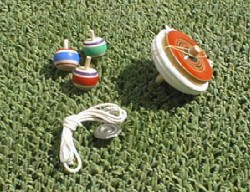 |
楽しい伝統的なお返し
○国と文化が違うけれども、こま遊びがあるという共通点を発見し、是非、お互いに文化の交換と交流を続けて日本のこまを贈りました(江戸こま、逆立ちこまとべいゴマ)。
Reciprocal cultural sharing-traditional Japanese tops were sent to the
Riverdale 6th Graders. (Edo era top, upside down top, and steel shell top.)
○休暇の伝統および文化的な楽しみを共有します。
Sharing holiday tradition and cultural fun.
 |
 |
 |
 |
 |
 |
 |
| けんだま Play at cup and ball |
こま Top |
べいごま BEIGOMA |
こま Top |
こんいちは Hi! | ||
![]() 学年委員の大都さんがこま「独楽」の説明をリバデール小学校へ送りました
学年委員の大都さんがこま「独楽」の説明をリバデール小学校へ送りました
May 5, 1999
Dear 6th Grade Class:
Hello! As your school year draws to an exciting climax with the 6th grade
graduation around the corner, here at Nakaaoto, we have just started to
get into the mode of the new 6th grade routine. If we were in America,
we would be graduating with you. However, our school year starts in April
rather than September, so we will graduate two terms later in the following
March.
In our first letter, we suggested that if only we could visit and spend
a day of school together, we could have so much fun learning about one
another.
In one sense during this school year, we have visited Riverdale, and likewise,
all of you have come to Nakaaoto-not in person, but through a type of communication
that is made with hands, minds, and hearts.
Now speaking of visits, we have one more question. In the past have you
ever visited a friend and taken along a favorite possession to share (a
toy, book, tape, game, etc...)? You may have received the item as a gift,
and as a result, can hardly wait to show the fun. After seeing and hearing
your excitement, your friend immediately rushes into their room to bring
out their favorite object, and together you both revel in an exciting moment
of sharing. What was discovered in that split-second when you presented
your treasure? What prompted your friend to share in return? Perhaps a
common interest or a related experience...?
To us, your handmade cards represented more than an introduction to your
culture and traditions. Each greeting card was like a real visit from every
Riverdale 6th Grade student to our Nakaaoto classroom. And just like the
two friends caught in a moment of "show and tell," when you presented
your holiday greetings, in return, we were prompted to share our treasure.
In your many holiday symbols, we unexpectedly discovered a common cultural
interest or related experience- a spinning top connected with a holiday
celebration. The discovery sent us running back into our cultural room
to dig into our closet filled with over two hundred years of tradition
and history to pull out an item to share with you. The holiday celebration
is New Years. Starting one hundred years ago, the new year rang with shouts
of triumph and cries of defeat. Neighborhood children gathered in the streets
to show off their handmade tops and challenge one another's spinning technique.
Although the shape and material of the top differed according to each region
within Japan, the way children played with the tops was similar. Most tops
were wrapped around the base with a cord, then thrown into an incredible
swift spinning momentum. The challenge of the game was not only to see
whose top was the longest spinning, but to also knock over every other
opponent's top to a dead stop. The spinning tops, driven like amusement
park bumper cars, were made to bump and bounce off one another. The child's
top which remained spinning after all the others had toppled was the winner.
The once popular New Year top spinning tradition is now history, but the
image of the top can be seen on New Year greeting cards (Ex. 1). And the
top which is called KOMA (こま) is still available in toy shops and is
a traditional entertainment taught through out the year at school and local
children community centers.
In an irresistible impromptu visit, we have sent you three types of KOMA.
However, if you look at the enclosed pictures (Ex. 2 and 3), a single glance
will tell you that the Japanese KOMA comes in many shapes and styles. The
story of the KOMA could fill a book with history which covers hundreds
of years; spinning through the palace of royalty to the streets of the
common people, traveling from the north to the south regions of Japan;
moving from the city to the countryside; and passing from an adult to a
child's hand. At one touch, the various tops would give you the feel of
bamboo, shell, wood, steel, tin, plastic. And if you could look into the
heart of the KOMA, you would see a reflection of many children's faces
filled with laughter, excitement, and even tears which were shed when the
spinning top came to a stop.
Come back with us in history once again to the EDO era* two hundred years
ago when the origami crane TSURU (Ex. 4) and the beautiful wood block prints
called UKIYOE (Ex. 5) were created. Walk with us down the streets of Tokyo
which at that time was called EDO, and you will see adults as well as children
throwing their spinning tops. In your package you will see a red and black
striped wooden top with a thick cord. This top is called EDOKOMA (江戸こま)
which means top of the EDO era. The thick cord is used to throw the top
into a fast spin.
Another popular children's top during the EDO era was an actual spiral
seashell used as a top. Like the EDOKOMA, the shell was wrapped around
with a cord then thrown into a whirling spin. However, instead of the street
surface, the shell was sent spinning on a straw mat spread over the lid
of a sugar or dry noodle barrel. (Ex. 6). The shell top had a special characteristic.
In order to increase the spinning momentum, sand or melted lead was put
inside the shell and sealed with wax.
The shell top continued to be a popular child's toy until the 1900's. Then
in the mid 1920's, a new top made of iron, which was cast into the shape
of a shell, gained popularity. The shape of the top resembles a water snail
shell. The name of the top is called BEIGOMA (べいごま). In Tokyo the cast
iron top could be bought at any local candy store at a price within a child's
allowance. The BEIGOMA is the most challenging top to spin. Unlike other
tops, the heavy weight and flat shape requires a special spinning technique.
Amongst the elementary school age children, 5th and 6th grade boys were
the ones who could master the difficult technique. The BEIGOMA neighborhood
champion was honored with high esteem. His prize was to collect every top
that he could out spin. The children would spin their tops on whatever
was available at the time-a thick straw mat or heavy cloth spread across
the mouth of a steel bucket.**
The little round striped top called GYAKUDACHIKOMA (逆立ちコマ) which means
"upside down top," has a unique phenomenal spinning motion. Like
the dreidel, the top is sent into a spin with the fingers. If given a full
spinning momentum, true to its name, the top will turn upside down to spin.
Originating in Tokyo and spinning across several generations, the top still
finds its place in present day toy shops.***
In our package, we have sent you only a few of the tops which are available
today (EDOKOMA, BEIGOMA, and GYAKUDACHIKOMA), along with photos and a bit
of KOMA history. However, unlike origami or wood block prints, the KOMA
cannot be fully understood with written words and pictures. It is the spinning
process which is the most enjoyable part of the KOMA. Japanese tops twirling
like daring acrobats can be spun not only on the floor, but on the hand,
on a string, or even in air. The best method of sharing would be for us
to visit Riverdale to show all of you how the tops spin. Impossible...but
a wonderful dream. Instead we chose the next best alternative-a video of
some of our 6th graders spinning the tops. Come and join us to see for
yourselves how the tops spin. And may you all enjoy a spinning voyage into
the past and present history of Japan.
Sincerely,
Mrs. Otsu and sixty-one 6th Grade Nakaaoto Elementary Students.
*EDO era is from 1603 to 1867.
** The material spread over a bucket on which the BEIGOMA was sent spinning
is itself a historical and cultural message. Starting from the EDO era,
a straw mat called GOZA(茣蓙)taken from tatami mats was used. After WWII
children used remnants of Self Defense Force tents or parachutes(自衛隊テントとパラシュート).
Today our Nakaaoto 6th grade boys used a plastic vinyl picnic spread designed
with a popular children's comic character. First used during the EDO era,
the lid of the empty sugar or dry noodle barrel on which the straw mat
was placed, over time changed to a steel bucket. The bucket used for cleaning
could be found in any home. Once again change brings new ideas. Steel buckets
are obsolete, so our students use a plastic wash bowl which is a common
everyday household item.
***The GYAKUDACHIKOMA is not only a fascinating child's toy, but also a
study in the laws of physics. The spinning phenomenon can be explained
by a set scientific equation dealing with precession. (歳差運動)
Bibliography ・ 参考
1. Encyclopedia Nipponica 2001 日本大百科全書 「こま」 2. まわれ! あしながごま
by 小林 実文 3.こまの技 by 高梨 俊博 4.日本人形玩具辞典 by 斎藤 良輔
5.ハンドクラフトシリーズNo.55 おもちゃ館 ・ 日本の郷土玩具
 |
 |
 |
 |
 |
 |
○リノリウム版は合成ゴムの版画で、木より柔らかくて彫りやすいそうです。リバデール小の5,6年生がつくりました。
The prints are "linoleum block prints".This material is fairly
easy for students to cut.
○社会科の授業から、アフリカのガーナGhanaという国のことわざを学んだそうです。自分の文化とアフリカの文化を比べるため、ことわざを選び、そのイラストを想像して描いたそうです。使ったことわざは自分の文化だけでなく、3つの国 アフリカ、アメリカ、中国です。これは総合的な学習です。
○ことわざは過去の世代の人々の知恵が凝縮した姿です。たくさんのことわざには、人間について万国共通の真理が含まれています。(クオーシー先生の説明)
Proverbs are wisdom of past generations in a condensed form. Many proverbs
contain universal truths about human nature. by Antoinette Quarshie Riverdale
Country School 6th Grade Teacher
![]() リバデール小から・ハロウィーンの紹介・中青戸小へ 2000,1,26
リバデール小から・ハロウィーンの紹介・中青戸小へ 2000,1,26
 |
 |
 |
 |
ハロウィーン・かぼちゃ祭りの紹介・アメリカから
1月26日、リバデール小学校から再びホリデイ小包みが届きました。中身は、6年生手作りのハロウィーンカード、写真とお菓子でした。
ハロウィーンとは、10月31日の夕方に行われるアメリカのお祭りです。思い思いに仮装した子供たちが、近所の玄関先で「トリック オア トリート」(ドアを開けてお菓子をくれないと、いたずらしちゃうぞ)と言って、飴やチョコレート等のお菓子をもらって歩くという楽しい行事です。小型のバケツ1杯にもなるお菓子を子供たちは、1年かけて食べるのが理想ですが、実際には、1週間で食べてしまうそうです。
このお祭りのシンボルには、日本では珍しいオレンジ色のカボチャが使われていて、ハロウィーンが近づくころ収穫され、どこのスーパーや八百屋でも握りこぶしくらいのものから、一抱えもあるような大きなものまで買うことができます。子供たちは、このカボチャの切りやすいという特徴を利用して、中身をくりぬいて、お化けの顔などを彫刻します。日が沈むころ中に立てたろうそくに火をともすと、なんとも不気味なお化けが、浮き上がります。
このように彫刻されたカボチャや、そのままのカボチャを玄関先に飾ったり、カボチャの絵を張ったりして、街中オレンジ色に塗り替えられます。
ハロウィーンには、このようにカボチャのオレンジ色、魔女や黒猫の黒、お化けの白の3色がよく使われます。送られてきたカードには、カボチャをデザインイした作品が多く見られました。
アメリカでは、行事をある特定の色で表現するという習慣があり、とても興味深く、アメリカ人のまとめ方、盛り上げ方のうまさが感じられます。 Yamada,Miho
"A Holiday Treat From America--Halloween"
On January 26, 2000 Nakaaoto received a cultural package from Riverdale
Country School 6th Graders. The package contained hand drawn and computer
graphic design "Happy Halloween" greeting cards. In addition
to the cards were photographs of a jack-o-lantern, a child wearing a trick-or-treating
costume, and an example of a decorated Halloween doorstep. Packages of
orange and yellow candy corn were also included.
At Naakaoto Elementary School we wanted to share the Halloween art with
all grades. A bulletin board was designed to display the cards and the
photographs. We also translated into Japanese a brief explanation of the
trick-or-treating traditions.
The very word "Halloween" when spoken in Japanese is an unusual
combination of sounds and is a little difficult to pronounce. To help the
children catch the meaning of the holiday, traditions, and symbols, we
coined in Japanese the phrase PUMPKIN FESTIVAL or KABOCHA MATSURI (Kabocha-pumpkin)
(Matsuri-festival). The orange pumpkin carved into a jack-o-lantern was
an eye catching holiday symbol that was depicted in many cards. Actually
the Japanese do grow pumpkin, but it is a dark green variety-an unlikely
candidate for the jack-o-lantern. The skin is tough and very difficult
to cut. Traditionally, the Japanese pumpkin is served as a boiled vegetable
dish.
| All 191 pieces of origami sent on March 21, 2000 carried a heartfelt thank you for the past two years of cultural exchange between Nakaaoto Elementary School and Riverdale Country School. |
リバデール小へ・折り紙お返し・ボランティア
ハロウインカードのお返しとして、もう一度、折り紙をアメリカへ贈りました。
クローシ先生によると、「折り紙の紹介が今年もあれば、6年生クラスにあがる子供達が喜ぶと思います。去年の事を見て、自分にも折り紙の体験を受けたいという子供達がいます。」ということです。
その期待に応えるように、ボランティア活動として、中青戸の6年1組と2組の折り紙に興味がある子供達と親が、191個の作品を作りました。今度、向こうに伝えたいことは、折り紙が世界の国の文化を表現ができるという事です。アメリカのホリディにも使える飾りを作り、クリスマスリース、ハヌカの星、バレンタインデーハートなどを紹介しました。それから、アメリカの子供達が興味を持っている恐竜、くじら、本物の形に近い動物と魚作品にも挑戦しました。
もう一つの伝えたいことは、千代紙の美しい色と模様でした。64枚の千代紙で折った楊枝入れはその紹介でした。
そして、遊ぶ例としては、手裏剣を一クラス分を折って、遊び方の説明も付け加え、楽しい国際交流の体験を考えました。折り紙の魅力的な特徴は、折ることだけではなく、遊ぶこともできるという―日本の子供達からのメッセージです。
◎文部省学習指導要領
5 総合的な学習の時間の学習活動を行うに当たっては、次の事項に配慮するものとする。
(1) 自然体験やボランティア活動などの社会体験、観察・実験、見学や 調査、発表や討論、ものづくりや生産活動など体験的な学習、問題解決的な学習を積極的に取り入れること。
(2) グループ学習や異年齢集団による学習などの多様な学習形態、地域 の人々の協力も得つつ全教師が一体となって指導に当たるなどの指導体制、地域の教材や学習環境の積極的な活用などについて工夫すること。
(3) 国際理解に関する学習の一環としての外国語会話等を行うときは、 各学校の実態等に応じ、児童が外国語に触れたり、外国の生活や文化などに慣れ親しんだりするなど小学校段階にふさわしい体験的な学習が行われるようにすること。
2000年(平成12年)から段階的に始められた。第5章 総合的な学習の時間… …。
1 目 標
探究的な見方・考え方を働かせ,横断的・総合的な学習を行うことを通して,
よりよく課題を解決し,自己の生き方を考えていくための資質・能力を次のとお
り育成することを目指す。
⑴ 探究的な学習の過程において,課題の解決に必要な知識及び技能を身に付け,課題に関わる概念を形成し,探究的な学習のよさを理解するようにする。
⑵ 実社会や実生活の中から問いを見いだし,自分で課題を立て,情報を集め,整理・分析して,まとめ・表現することができるようにする。
⑶ 探究的な学習に主体的・協働的に取り組むとともに,互いのよさを生かしながら,積極的に社会に参画しようとする態度を養う。
文部科学省:今、求められる力を高める総合的な学習の時間の展開(小学校編)
https://www.mext.go.jp/a_menu/shotou/sougou/1300434.htm
![]() 国際理解学習[International
Understanding Learning]
国際理解学習[International
Understanding Learning]
![]() 図工と総合の学習[Period for Integrated Studies Plans]
図工と総合の学習[Period for Integrated Studies Plans]